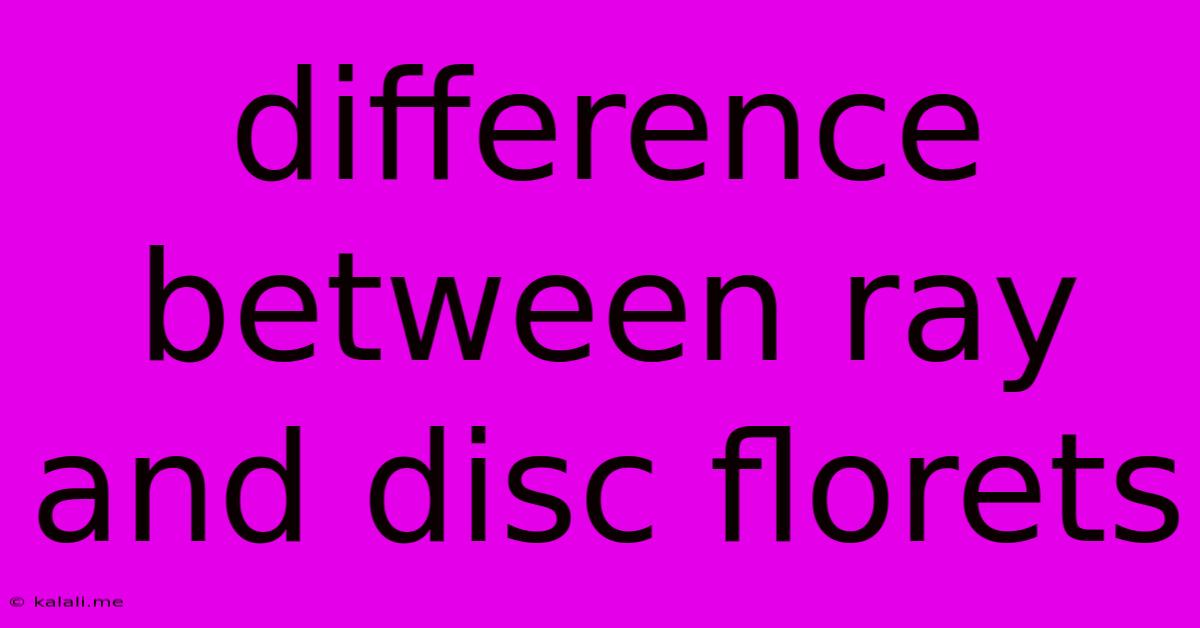Difference Between Ray And Disc Florets
Kalali
Jun 16, 2025 · 3 min read

Table of Contents
Understanding the Difference Between Ray and Disc Florets
Want to understand the intricate beauty of composite flowers like sunflowers and daisies? Then you need to know the difference between ray and disc florets. These tiny flowers, packed together to create the impressive blooms we admire, are actually quite distinct in their structure and function. This article will delve into the morphological differences, the roles they play, and provide examples to illustrate these fascinating floral components.
Meta Description: Discover the key differences between ray and disc florets in composite flowers like sunflowers and daisies. Learn about their morphology, functions, and the role they play in plant reproduction.
What are Ray and Disc Florets?
Ray and disc florets are the individual flowers that make up the "head" or "capitulum" of composite flowers (Asteraceae family). This family is incredibly diverse, encompassing thousands of species, including sunflowers, daisies, asters, and marigolds. Instead of having single flowers, these plants boast numerous tiny flowers clustered together, creating the illusion of one large flower.
Morphological Differences Between Ray and Disc Florets
The most striking difference lies in their appearance:
-
Ray Florets: These are the outer flowers, typically arranged in a ring around the central disc. They're usually showy, with a single, strap-like petal (ligulate corolla) that often attracts pollinators. Think of the yellow "petals" of a sunflower – those are actually ray florets. They are often sterile, meaning they don't produce seeds.
-
Disc Florets: These are the small, tubular flowers that make up the central disc of the composite flower. They're typically less showy than ray florets, and their petals are fused together to form a tube (tubular corolla). These florets are usually bisexual (containing both male and female reproductive parts) and are responsible for seed production.
Here's a table summarizing the key differences:
| Feature | Ray Floret | Disc Floret |
|---|---|---|
| Shape | Strap-like (ligulate) | Tubular |
| Petals | One, elongated | Five, fused into a tube |
| Reproductive | Usually sterile | Usually bisexual (fertile) |
| Function | Pollinator attraction | Seed production |
| Location | Outer ring of the flower head | Central disc of the flower head |
The Roles They Play
While seemingly decorative, ray and disc florets play crucial roles in the plant's reproductive success:
-
Ray Florets: Primarily responsible for attracting pollinators such as bees, butterflies, and other insects. Their vibrant colors and sometimes fragrant scents lure these visitors to the flower head.
-
Disc Florets: These are the workhorses of reproduction. They produce pollen and ovules, leading to fertilization and the development of seeds.
Examples in Different Composite Flowers
The ratio and prominence of ray and disc florets vary greatly across different species.
-
Sunflowers: Have a large number of both ray and disc florets. The bright yellow ray florets are prominent, while the numerous small disc florets form the central brown area.
-
Daisies: Typically exhibit a ring of white or colored ray florets surrounding a yellow disc of disc florets.
-
Asters: Often feature numerous ray florets with a smaller, compact disc.
-
Dandelions: Consist entirely of disc florets, lacking ray florets altogether.
Understanding the differences between ray and disc florets provides a deeper appreciation for the complexity and beauty of composite flowers. Their specialized roles in pollinator attraction and seed production highlight the incredible adaptations that have enabled this diverse plant family to thrive in various environments across the globe. Further exploration into the genetics and evolutionary pressures that have shaped these floral structures promises even more fascinating discoveries.
Latest Posts
Latest Posts
-
Which Of The Following Statements Is True Of Lake Victoria
Jun 16, 2025
-
Which Of The Following Best Describes A Body In Equilibrium
Jun 16, 2025
-
50 Of What Number Is 80
Jun 16, 2025
-
What Is The Si Unit Of Displacement
Jun 16, 2025
-
Lcm Of 6 4 And 10
Jun 16, 2025
Related Post
Thank you for visiting our website which covers about Difference Between Ray And Disc Florets . We hope the information provided has been useful to you. Feel free to contact us if you have any questions or need further assistance. See you next time and don't miss to bookmark.